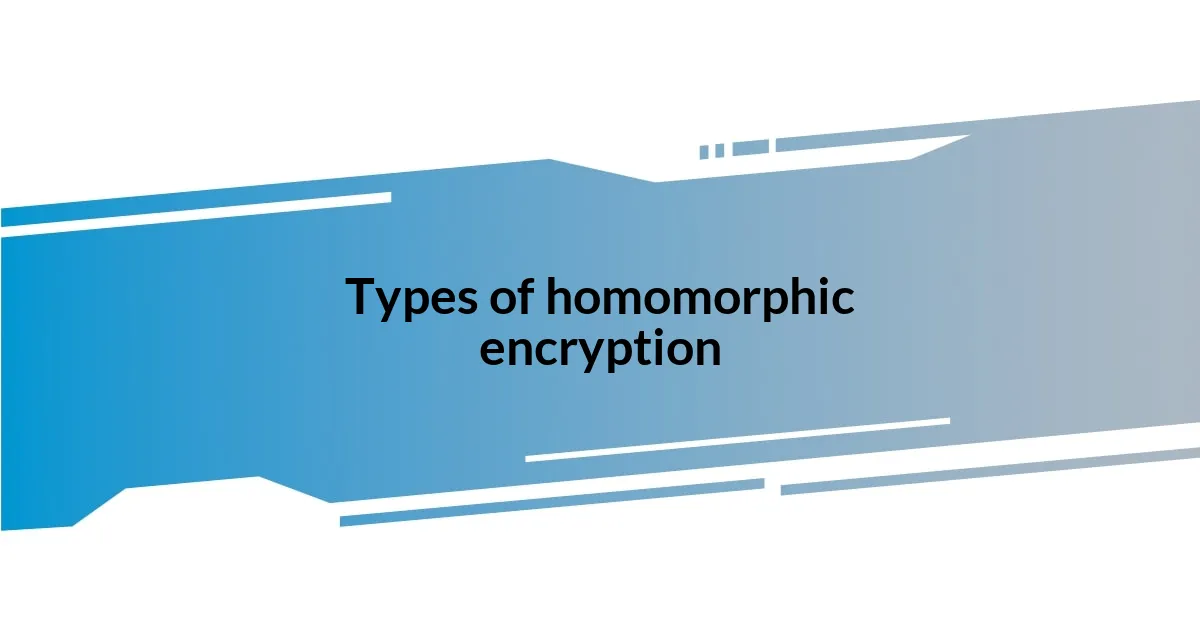Key takeaways:
- Homomorphic encryption enables computations on encrypted data, enhancing privacy and security in sectors like healthcare and finance.
- There are three main types of homomorphic encryption: partial, somewhat, and fully, each offering different balances of utility and security.
- Challenges include computational overhead, complex key management, and integration difficulties that need to be addressed for practical implementation.
- Future trends suggest hybrid approaches and user-friendly tools may enhance the adoption and functionality of homomorphic encryption.

Understanding homomorphic encryption
Homomorphic encryption is a fascinating concept that allows computations to be performed on encrypted data without needing to decrypt it first. I remember the first time I grasped this idea—it felt like opening a door to a world where privacy and data handling could coexist seamlessly. Imagine being able to analyze sensitive information without ever exposing it; isn’t that an exciting prospect?
What truly captivates me about homomorphic encryption is its potential impact on fields like finance and healthcare. For instance, think about how a hospital could analyze patient data while keeping personal information fully secure. This dual benefit of utility and confidentiality is something that resonates with me on a personal level, as I believe in the importance of privacy in our increasingly digital lives.
Delving deeper, the mathematics behind homomorphic encryption can be complex, yet it’s this complexity that enables such powerful functionality. I often find myself pondering whether the benefits outweigh these challenges. Can we truly harness this technology to protect ourselves while embracing the advancements that come with data analysis? Understanding these nuances is crucial for anyone interested in the future of secure data processing.

Types of homomorphic encryption
Homomorphic encryption can primarily be categorized into three main types: partial, somewhat, and fully homomorphic encryption. Each type represents a unique balance between the level of computational capability and the extent to which data remains encrypted. Personally, I find the complexity of these categories intriguing as they reveal the trade-offs that are often necessary in the realm of data security.
Partial homomorphic encryption allows specific types of operations—like addition or multiplication—to be performed on the ciphertext, but not both simultaneously. This limitation often sparks my curiosity; it poses the question of how much utility we can extract without compromising security. On the other hand, fully homomorphic encryption is a game-changer, permitting arbitrary computations on encrypted data. I can’t help but feel excited about the potential applications this could unlock—but I also wonder about the practical implementation challenges that would need to be overcome.
In my exploration, it’s evident that somewhat homomorphic encryption strikes a middle ground, enabling certain computations while still ensuring data protection. This type resonates personally with me because it reflects the balancing act we often face in our daily lives—protecting our privacy while still engaging with the world around us. It reminds me of the careful navigation we must all undertake in a data-driven society.
| Type | Characteristics |
|---|---|
| Partial Homomorphic | Supports either addition or multiplication on ciphertext but not both. |
| Somewhat Homomorphic | Allows limited operations, providing a balance between security and utility. |
| Fully Homomorphic | Permits any computation on encrypted data, offering maximum flexibility. |

Benefits of homomorphic encryption
The benefits of homomorphic encryption are profound and multifaceted, resonating deeply with modern societal needs. For me, the most compelling advantage is the enhancement of data privacy. By allowing computations on encrypted data, users can retain ownership of their sensitive information while still leveraging powerful analytical tools. This strikes a personal chord as I reflect on the countless times I hesitated to share my data with services, fearing how it might be used or exposed.
- Privacy Preservation: Sensitive data remains protected even during processing.
- Data Sharing without Compromise: Organizations can collaborate on data analysis while keeping individual information confidential.
- Compliance with Regulations: Homomorphic encryption can help organizations meet stringent data protection laws, reducing the risk of legal repercussions.
Moreover, consider the flexibility this technology introduces. I think about how it could revolutionize sectors like finance; institutions could perform risk assessments using customer data without ever accessing the raw information. This possibility makes me excited about a future where businesses can innovate responsibly, maximizing both efficiency and trust with their clients. It’s an invitation to rethink how we approach data in a world that increasingly values transparency without sacrificing security.
- Enhanced Collaboration: Teams can work together on sensitive projects without exposing confidential information.
- Innovative Applications: New services can emerge that leverage encrypted data, benefiting society without exposing vulnerabilities.
- Reduced Risk of Data Breaches: Even if data is intercepted, it remains unusable without the decryption keys.

Use cases in real-world applications
When I think about the practical applications of homomorphic encryption, healthcare quickly comes to mind. Imagine a scenario where medical researchers analyze patient data to discover new treatments, all without ever accessing identifiable information. I can picture the relief of patients knowing their sensitive health details are protected while contributing to groundbreaking research. How empowering would that be for both patients and researchers alike?
Another compelling use case is in the financial services sector. Financial institutions face immense pressure to protect their customers’ data while still providing personalized services. If they could utilize homomorphic encryption, they could conduct credit assessments or fraud detection without exposing sensitive personal information. This concept resonates with me on a personal level; I’ve often felt uneasy sharing my financial data. Just envision a world where I can engage safely, knowing my information remains under lock and key, even during analysis.
Moreover, this technology can revolutionize how cloud computing works. With more companies moving to the cloud, the concern about data exposure continues to grow. As I think about my own experiences with cloud services, the notion of processing encrypted data means organizations can collaborate more freely, all while maintaining a layer of security that assures clients their information is safe. Isn’t it exciting to consider a future where we can maximize collaboration without sacrificing confidentiality?

Steps to implement homomorphic encryption
Implementing homomorphic encryption requires a structured approach to ensure the process is efficient and effective. Firstly, I recommend selecting the right homomorphic encryption scheme based on your needs. For instance, if you are particularly worried about performance, you might prefer a partial homomorphic encryption method, which allows for specific operations while managing the trade-off with computational speed. I remember grappling with this decision myself; choosing the right tool felt like browsing through a tech store filled with options, each promising something unique.
Next, careful planning is essential for integrating homomorphic encryption into existing systems. This stage often involves understanding your data flow and identifying where encryption fits seamlessly. I’ve found that mapping out processes can be tremendously beneficial; it’s like drawing a treasure map for your data’s journey. What surprised me during this planning phase was how many points I previously overlooked where sensitive information was exposed. This realization made me reconsider not just how I handle data but how organizations can radically improve their security posture.
Once the scheme is in place, I believe thorough testing and validation are crucial. This means simulating real-world scenarios to ensure the encrypted computations yield accurate results. For me, this echoes the importance of having a safety net; it’s reassuring to know that every possible failure mode has been considered. I learned that by involving a diverse team in this testing phase, I could gather a broader range of insights, leading to a more robust implementation that truly meets users’ needs. Wouldn’t you agree that a collaborative effort often leads to better outcomes in any project?

Challenges and limitations
Homomorphic encryption, while promising, faces significant challenges that can’t be overlooked. One major limitation is its computational overhead. I recall a time during a project where I implemented a basic encryption method; the delays in processing made me question the practicality of using it at scale. Can you imagine how frustrating it must be for developers to grapple with the trade-off between security and efficiency?
Another challenge lies in the complexity of key management. Managing encryption keys isn’t just about having them; it’s about ensuring they’re protected and accessible when needed. I learned this the hard way when an improperly managed key caused a delay in accessing encrypted data crucial to a timeline. It’s a reminder that even the best technology can falter if the surrounding processes aren’t as robust. How do organizations strike a balance between accessibility and security in their day-to-day operations?
Lastly, the practical implementation of homomorphic encryption can be daunting. I remember attempting to navigate the murky waters of integrating this technology into an established system—it felt like trying to fit a square peg into a round hole. Without extensive knowledge of both encryption principles and the existing infrastructure, many might find themselves overwhelmed. Is there a way to simplify this integration process? Perhaps the answer lies in more user-friendly frameworks and educational resources, ensuring that this revolutionary technology doesn’t remain confined to the hands of experts alone.

Future trends in homomorphic encryption
The landscape of homomorphic encryption is continuously evolving, with some exciting future trends on the horizon. I’ve noticed a growing emphasis on hybrid approaches that combine homomorphic encryption with other cryptographic methods. This fusion may provide enhanced security while optimizing performance—a balance I felt was often lacking in discussions around encryption. the question arises: could this cross-pollination of techniques lead us to a new standard in secure data processing?
I also see potential advancements in user-friendly interfaces for developers. Reflecting on my own early experiences, I remember wrestling with overly complex frameworks that made implementation feel like a Herculean task. I believe that as this technology matures, we’ll witness the rise of more intuitive tools that demystify the setup process. Could these enhancements spark wider adoption of homomorphic encryption across various industries, especially among organizations that may shy away due to existing complexity?
Moreover, the integration of machine learning with homomorphic encryption is an intriguing prospect I foresee. Imagine being able to perform data analytics on encrypted datasets without ever exposing sensitive information! I once faced a situation where I wished I could derive insights from encrypted health records, but it seemed impossible at the time. If we can meld these two fields, might we not unlock groundbreaking possibilities for privacy-preserving data analysis? It’s a thrilling thought that fills me with optimism about the future of secure data usage.